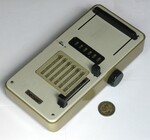
The Beaver adding machine
Video
History
Advertisements and articles
Links
The Beaver is a small adding machine made by Ito-ya in Japan in the second half of the 1960s. It has a plastic case with a metal front plate. There is a 6-digit main register visible in a window, and there are 6 sliders underneath it with which you can input a number to add or subtract. To their right there is a larger slider, or trigger, and pushing that up will add the number that was entered to the main register, and reset the input pins while doing so. The knob in the right hand side is turned to reset the register.
There is a small switch on the left that switches between addition and subtraction. Subtraction is done by complementary digits, and in subtraction mode the digits next to the input pins change from black for addition to red for subtraction, and reverse their order. The zero position of the input pins is then at the bottom, and the big lever at the top can be used to push all the input pins down to zero to prepare for setting the number to subtract.
The instructions on the underside of the machine say:
| ⊕ 25+82=339 | ⊖ 568-35-12=52 |
|---|---|
|
|
The serial number is 440,211 but it is not known what the numbering scheme was. I suspect that the numbering started at 440,000 and that fewer than 500 were made.
The mechanism unfortunately has a weak point. When the trigger is pulled, a frame moves upwards, shifting the input pins and transferring their value to the register. The carries are performed at the end of the frame's travel. The frame however is not fully rigid. There is an axle with plastic gears underneath it that should ensure that the two sides of the frame move exactly in concert, but the gears have cracked and slip on their axle. The frame is therefore somewhat skewed, and does not trigger the carries in the left half of the register. Subtraction by complementary addition relies on such carries so no longer works on this machine.
There is hardly any information about this adding machine to be found on the internet. Only Wilfried Denz on his Rechnen Ohne Strom site provides some useful leads.
The Beaver calculator was sold and exported by the Japanese company ITO-YA Ltd. This company was founded by Katsutaro Ito in 1904 when he opened a stationery store in Tokyo. The company slowly grew, despite setbacks such as the Great Kanto earthquake destroying the store in 1923, and the business closing for several years due to supply problems at the end of the second world war. In 1964 the Beaver adding machine was one of its many products, and although Ito-ya was still only operating in Japan, they had begun exporting some products, including the Beaver. Outside of Japan it seems to have been sold only in the USA and in the Netherlands. In 1975 Ito-ya established an American branch in Los Angeles, but by then the Beaver was of course no longer being manufactured. Itoya still exists and has stores in Japan, and their products are available in many stores in the USA.
I have not found any patents for the Beaver adding machine, though it seems likely to me that there is a Japanese patent for it. I suspect that only a single batch of Beaver adders was produced which Ito-Ya then acquired for resale.
I have found very little mention of the Beaver calculator in online archives. There is one ad from October 1964, which is around the time that the name Beaver was trademarked for its use in adding machines. In 1968 there was mention that Itoya made a manual adding machine, so presumably it was still available then. The tradename Beaver was still listed in the tradenames dictionary until the 1990s, owned by Kanematsu Gosho USA which was the sales agent in the USA. The only mention I found in Dutch newspapers was in a 1971 ad selling a large assortment of second hand office machines.
© Copyright 2022 Jaap Scherphuis, mechcalc a t jaapsch d o t net.